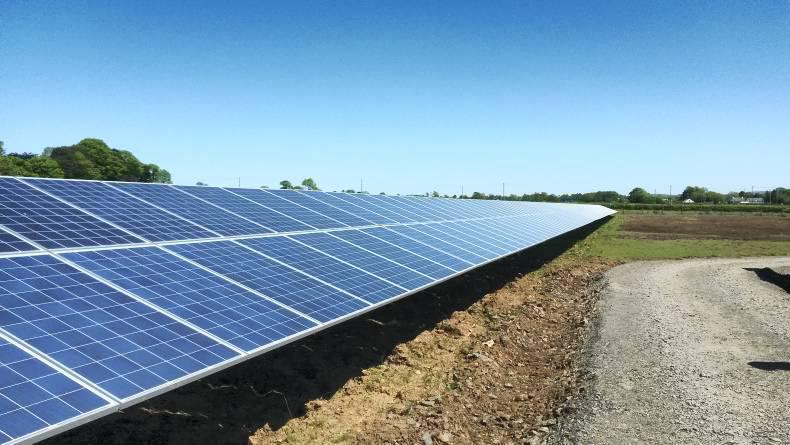The first large-scale solar farm in NI was opened last week at Aldergrove near Antrim, which will supply approximately 27% of Belfast International Airport’s annual electricity needs through a private wire connection.
The 33-acre site contains 18,000 silicon-based photovoltaic solar panels and is situated adjacent to the airport on the Crookedstone road. The solar farm also has a grid connection for surplus electricity to be exported when supply outstrips demand from the airport. Peak capacity is 4.83 Megawatts (MW). However, this has been curtailed to 3.4MW to match availability on the grid.
The project was funded and developed by renewable energy company Lightsource which has developed around 200 solar farms across 6,000 acres in Britain. At the launch of the Aldergrove site last week, Lightsource chief executive Nick Boyle appeared optimistic for the future of new solar developments in NI even with continued uncertainty in the renewable energy sector here.
NIRO
That uncertainty mainly stems from the fact that there is no new incentive scheme set to replace the NI Renewable Obligation scheme which closes to new applications from next April. There are also issues surrounding availability of grid connections for renewable projects due to congestion on the electricity distribution system.
Speaking to the Irish Farmers Journal, Boyle said: “We have around another 15 sites to build between now and the end of March. Our intention is to continue to build next year and beyond in NI.”
The land at the Aldergrove site is owned by Lightsource. However, the vast majority of projects developed by the company are on land leased from farmers. Boyle said that landowners are paid an index-linked rent per acre for 25 years with a possible five-year extension.
“In the shorter term the areas we are most interested in is land adjacent to very large electricity users where we can enter into an agreement with the user to buy electricity from the solar farm,” he said.
Retail price
Selling electricity to a large scale user through a power purchase agreement allows Lightsource to receive more than the wholesale price for exporting to the grid (currently around 4p/kWh). Effectively the price negotiated competes against the retail price of electricity (currently around 14p/kWh on most tariffs).
“I believe we are a couple of years away from being able to connect straight into the grid because the wholesale price that we would get for that electricity is significantly less and the financial model does not work as yet,” Boyle said.
He described the reductions and closures of renewable incentives as “extremely challenging” but said that subsidies were always going to be more lucrative for the initial development of the technologies. Availability of grid connections to export surplus electricity as well as planning permission can be other factors limiting site selection.
Grazing
Boyle said that 70% of sites that Lightsource have developed have grazing rights allowing sheep to be grazed between and below rows of solar panels.
However, once land is converted over, the advice from DAERA is that the principal purpose of the land is non-agricultural activity. This means it is not eligible for basic payment or any other area based payment, including agri-environment schemes.
Many in the industry assume that this could also have implications for agricultural tax relief when it comes to inheritance or capital gains tax, although a case like this has not occurred in NI to date.






 This is a subscriber-only article
This is a subscriber-only article











SHARING OPTIONS: